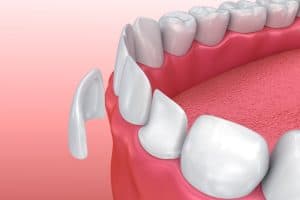
While they share the same goal, veneers and bonding differ in treatment process, specific uses, and longevity. Here’s what you should know about each.
What Are Veneers?
Veneers are thin porcelain shells that cover the front surface of your teeth. They are custom-made to match your smile, correcting issues such as:
- Irregular tooth shape
- Broken or chipped teeth
- Gaps between teeth
- Deep discoloration that doesn’t respond to teeth whitening
Placing veneers usually involves two or more visits. In the first visit, Dr. Manassra lightly etches the tooth surface to make room for the veneer and takes impressions of your tooth. These impressions guide the fabrication of your new custom restorations. Dr. Manassra expertly chooses the porcelain shade to exactly match your natural teeth.
You’ll wear temporary veneers until your permanent ones are ready. In the second visit, Dr. Manassra uses dental cement to attach the veneers to your teeth and makes any adjustments needed.
Porcelain closely mimics tooth enamel in the way it reflects light, so the results are remarkably natural-looking. Veneers are stain-resistant, strong, and can last for many years with proper care.
What Is Dental Bonding?
Bonding is a more conservative treatment that uses tooth-colored resin to cover imperfections or reshape teeth. It can correct the same concerns as porcelain veneers.
Bonding usually requires only one visit to Manassra Dental. For this procedure, Dr. Manassra mixes composite resin shades to match your natural teeth. He then expertly sculpts the resin to your teeth and uses a special light to harden it in place.
Bonding can look very natural and is durable. However, it’s not as strong as porcelain veneers and may need touch-ups or replacement over time.
Key Differences Between Veneers and Bonding
Both treatments have advantages depending on your needs. Some main differences include:
- Durability: Veneers often last 10 years or more, while bonding typically lasts 3–10 years.
- Aesthetics: Veneers resist stains, but bonding can stain.
- Treatment time: Bonding requires one appointment, while veneers require two.
- Cost: Bonding is generally more affordable, though veneers offer longer-lasting results. So, the cost can even out over time.
- Tooth preparation: Veneers require a small amount of enamel removal, whereas bonding preserves more of the natural tooth.
The best choice depends on your goals, your oral health, and how much change you want to see.
Veneers and Bonding in San Jose, CA
Considering veneers or bonding? Dr. Manassra and our team at Manassra Dental can guide you through the options. Call our San Jose, CA, office today at (408) 809-7760 to schedule a consultation and find out which treatment is best for your smile.



